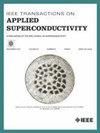用J-A公式模拟开芯和闭芯超导故障限流器
IF 1.8
3区 物理与天体物理
Q3 ENGINEERING, ELECTRICAL & ELECTRONIC
引用次数: 0
摘要
高值不对称短路电流测试电气设备的稳健性,增加了断路器和变电站组件损坏的风险。故障电流限制器(fcl)提供了一种可行的解决方案,可以减轻这种影响,而无需进行改造或改变布局。其中,超导故障限流器(SFCL),特别是饱和铁芯型(SIC-SFCL),在直流和交流变电站中都表现出了良好的性能。本研究通过在相同条件下的二维有限元模拟,比较了两种SIC-SFCL子拓扑,开放核(OC)和封闭核(CC)。该模型采用J-A公式,将电流密度(J)与磁矢量势(A)联系起来,从而可以准确地表示超导带。仿真分析了SFCLs对不同故障场景的响应,评估了其在缓解故障电流方面的有效性。此外,还检查了稳态运行时的电压降、磁通密度和电网谐波注入。结果表明,对于1 kA故障,OC配置在初始峰值时的故障电流限制比CC配置高10%;对于3ka的故障,这种优势增加到12%。与CC配置相比,OC配置也显示出降低的谐波水平。CC SIC-SFCL呈现奇数次谐波,第三次,第五次,第七次和第九次,与OC模型相比,这可能导致更大的磁损失和效率降低。相反,稳态压降在CC配置中比在OC配置中更低。这些结果突出了两种配置之间的权衡,作为未来SIC-SFCL项目的基础。本文章由计算机程序翻译,如有差异,请以英文原文为准。
Simulating Superconducting Fault Current Limiters With Open-Core and Closed-Core Using the J-A Formulation
High-value asymmetrical short-circuit currents test the robustness of electrical equipment, increasing the risk of damage to circuit breakers and substation components. Fault current limiters (FCLs) offer a viable solution to mitigate such impacts without requiring retrofits or layout changes. Among these, the superconducting fault current limiter (SFCL), particularly the saturated iron-core variant (SIC-SFCL), has shown promising performance in both DC and AC substations. This study compares two SIC-SFCL sub-topologies, open-core (OC) and closed-core (CC), through two-dimensional finite element simulations under identical conditions. The model employs the J-A formulation, which relates the current density (J) to the magnetic vector potential (A), allowing for an accurate representation of superconducting tapes. The simulations analyze the response of the SFCLs to different fault scenarios, evaluating their effectiveness in mitigating fault currents. Additionally, voltage drops during steady-state operation, magnetic flux density, and harmonic injections into the grid are examined. Results indicate that the OC configuration exhibits a 10% higher fault current limitation during the initial peak compared to the CC configuration for a 1 kA fault; this advantage increases to 12% for a 3 kA fault. The OC configuration also exhibits reduced harmonic levels compared to the CC configuration. The CC SIC-SFCL presents odd harmonics, third, fifth, seventh, and ninth, which can lead to greater magnetic losses and reduced efficiency compared to the OC model. Conversely, the steady-state voltage drop is lower in the CC configuration than in the OC one. These results highlight the trade-offs between both configurations, serving as a foundation for future SIC-SFCL projects.
求助全文
通过发布文献求助,成功后即可免费获取论文全文。
去求助
来源期刊

IEEE Transactions on Applied Superconductivity
工程技术-工程:电子与电气
CiteScore
3.50
自引率
33.30%
发文量
650
审稿时长
2.3 months
期刊介绍:
IEEE Transactions on Applied Superconductivity (TAS) contains articles on the applications of superconductivity and other relevant technology. Electronic applications include analog and digital circuits employing thin films and active devices such as Josephson junctions. Large scale applications include magnets for power applications such as motors and generators, for magnetic resonance, for accelerators, and cable applications such as power transmission.
 求助内容:
求助内容: 应助结果提醒方式:
应助结果提醒方式:


